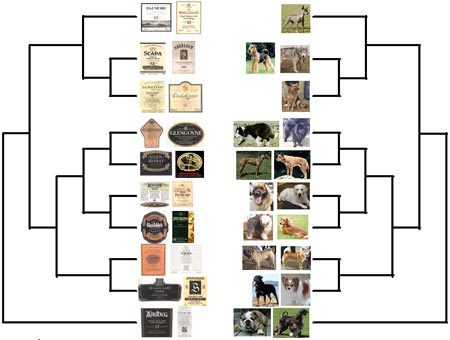By Lex Kraaijeveld, UK
Testing the Miller-hypothesis: Matching dogs with whisky
In the editorial of issue 20 of Whisky Magazine, Marcin Miller asked whether there is a link between pure dog breeds and single malt whiskies (with mongrels being equivalent to blends). Marcin contemplated that his dachshund would be a Tamnavulin, because of the ‘short legs’, the ‘lightly scented and floral nose’, the ‘notes of drains, brackish water and farmyard’ and the ‘very, very, very long finish’.
When I first read this idea of matching the characteristics of dog breeds with those of single malts, I felt it was a light-hearted joke. But the matter sort of kept nagging at the edge of my conscience until I saw an article in Science. In this article, the authors investigate the origin of dogs and present evidence that suggests that dogs evolved from wolves more than once and that this may have happened much longer ago than previously thought: over 100,000 years ago instead of 14,000 (for anyone interested, the full reference of the article is: Vila et al, 1997. Multiple and ancient origins of the domestic dog. Science 276: 1687-1689; a pdf-file of the article is available from me in case people are interested). Included in the article is information on the genetic relationship between 67 breeds of dog.
A thought suddenly struck me. I can look at Marcin’s hypothesis scientifically! I can compare the genetic similarity of dog breeds from this Science article with the taste similarity of single malt whiskies as calculated by David Wishart in his cluster analysis! In biology, you do this by drawing up relatedness ‘trees’ and see how well they match, how similar their ‘branching’ is. If you see a close match between two ‘trees’, that usually means there has to be some sort of link or connection, because the chances of a close match occurring by coincidence are slim…
OK, so I got to work extracting the necessary information from the Science article and drawing up the genetic ‘tree’ of the 67 dog breeds. That finished I put it next to the taste similarity ‘tree’ I had drawn up earlier from David Wishart’s cluster analysis of 86 single malt whiskies (see Whisky Magazine issue 14, page 44). A shock went through my spine: the ‘trees’ were perfect matches!! Whether he knew it or not, Marcin was on to something big…
So here it is: the connection between pure breed dogs and single malt whiskies, backed up by what is, without a shadow of a doubt, the most thorough scientific investigation of the subject. David Wishart’s ‘tree’ on the left, the dog ‘tree’ on the right, with each of the whisky or dog clusters represented by one or two single malts or dog breeds, respectively.
Let’s pick out a few matches and see whether we can understand the links. First of all, look at the top cluster in David Wishart’s ‘tree’. Called cluster A, this cluster contains some of the most heavily-sherried singe malts (such as Macallan). And it appears that heavy sherry is linked to the xoloitzcuintli, or Mexican hairless dog. Why? No clue, but that’s what comes out. The more honeyed malts such as Scapa and Balvenie are linked to dog breeds such as the Airedale terrier and the German shepherd. I don’t see the honey in either breed, so another baffling link. A few clusters down, it gets a bit clearer: malts like Glen Moray and Bunnahabhain are linked to dogs like the greyhound and the dingo. Dingo’s are a very primitive breed of dog and greyhounds are also very old. Does that say something about Glen Moray and Bunnahabhain being similar to a very early style of whisky? Very interesting possibility…
Linked to the cluster with Glenmorangie and Oban, characterised by spicy notes, we find a dog cluster with several oriental breeds such as the shar-pei and the shiba inu. Obviously, we’re looking at oriental spices here. The peat monsters are all included in the bottom cluster (J in David Wishart’s analysis). Linked to them is for instance the English bulldog. Not hard to see this link between two heavy-weights; obviously, bulldogs are the peat monsters of the dog world! And I can also see the match between the less peaty malts in this cluster, such as Clynelish, and an elegant breed as the Afghan hound. And what about Marcin’s dachshund, which started all this? The dachshund is in the dog cluster which links to a whisky cluster with sweet and floral notes (such as Glenfiddich and Speyburn). So yes, Marcin was right about the floral notes of a dachshund (!), but not about the link with Tamnavulin which is clustered together with the more spicy malts.
Obviously, more genetic work is needed to get to the bottom of this very intriguing link between single malt whiskies and pure dog breeds. First of all, the 67 dog breeds in the Science article make up less than 10% of all dog breeds in the world. The genetic code of the dog has been sequenced and I think the biological world is in for a shock. Marcin, and those who have read this article, will not be surprised that, very soon, it will be discovered that dogs have genes in common with barley, yeast, peat moss and oak. I’m off to do the necessary research…
Thanks to Marcin Miller for providing the inspiration for the research presented in this article.
